Where you see this button
Spider Collector's Journal (24th page: 2014) Copyright © 2014 by Rod Crawford
Here's the 24th page of narratives of fun (and not so fun)
trips to collect spiders for research at the Burke
Museum, some accompanied by capable field volunteers Hannah Dykstra, Michael Sweepe and others. Most also appeared in Scarabogram, newsletter of "Scarabs:
The Bug Society." Dates of field trips head each paragraph. Maps showing
the location of sites within Washington state follow the grid system outlined
in the Washington
Spider Checklist. RETURN
TO INDEX
Where you see this button ![]() in a
field trip account, click it to get a page of collecting site photos!
in a
field trip account, click it to get a page of collecting site photos!
 |
![]() 13 III 2014: Hannah Dykstra from Georgia, my new butterfly-mounting volunteer, had shown a keen interest in spider collecting trips. But since she became available the weather had been uniformly lousy. Finally, at the tail end of winter in mid-March we had a 3-day period of collecting weather; and on Thursday the 13th, Hannah and I set off for Lake Cavanaugh in south central Skagit County, selected as a fairly remote spot not likely flooded by recent torrential rains, and reachable during a short day. Our site was about 3 miles NW of the 9-days-later Oso landslide disaster.
13 III 2014: Hannah Dykstra from Georgia, my new butterfly-mounting volunteer, had shown a keen interest in spider collecting trips. But since she became available the weather had been uniformly lousy. Finally, at the tail end of winter in mid-March we had a 3-day period of collecting weather; and on Thursday the 13th, Hannah and I set off for Lake Cavanaugh in south central Skagit County, selected as a fairly remote spot not likely flooded by recent torrential rains, and reachable during a short day. Our site was about 3 miles NW of the 9-days-later Oso landslide disaster.
We reached the mostly-private, 2.6-mile-long lake by a paved but little-traveled road that winds over 15 miles eastward from State Highway 9 and goes nowhere else. The morning haze was already burning off when we reached the state public boat launch at the east end. Habitats here didn't appear promising (soaking wet and entwined with blackberry) so after taking 4 spider species from the outhouse, we turned around and returned to my planned main site, where the lake-perimeter road briefly enters a large tract of state forest. Here we parked in a band of mature timber around a beaver-created wetland, with clearcuts on both sides. Oddly enough this wetland apparently drains east, away from the nearby lake. Unlike the lakeside, this site was thankfully not drenched with dew.
I'd hoped this site would have bigleaf maple trees (nearly universally found in riparian zones of this area) with gobs of litter under them. No such luck, not a maple in sight! I also thought some sedge or marsh grass would be growing around the wetland, but again, no such luck! Maybe the beaver activity is too recent for these communities to have developed. However, despite these lacks we did all right. I began by sifting 10 species from the rich moss habitats, followed by 5 more from small pockets of litter under sparse alder and cottonwood trees. Hannah and I beat salal foliage, available in some abundance, for 5 species not in the sift samples; I lucked into a very early-maturing Theridion californicum while Hannah took what I thought was a Linyphantes, but turned out to be the much rarer Halorates plumosus. Then we beat fir and hemlock foliage at the edge of the adjacent clearcuts, adding 8 more species to the mix (though surprisingly lacking in salticids). One of the clearcuts had dense, tall but still leafless salmonberry between the trees while the other one had prostrate, last-year's grass as a ground cover with no sign of spring sprouting yet. Lots of wolf spiders were running about but none were mature. Bark pieces scattered on the forest floor appeared promising, but produced no spiders. Although many people live around the lake, our site was delightfully peaceful once the log trucks stopped running in early afternoon. Despite the various lacks, we had a solid sample of 30 spider species before we had to leave in order for Hannah to make a 5:30 appointment.
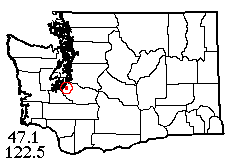 |
![]() 23 III 2014: A spell of good weather was ending; new field driver Hannah was unavailable (and on the point of taking a month off), so I pulled another bus-transport field plan out of my hat. This time the bus took me to Lakewood Station (in a southern suburb of Tacoma) from which I walked just under 2 miles on busy arterials to Seeley Lake Park, which consists of a marshy/swampy wetland (very little open water on aerial photos) ringed by a trail. Not exactly a "natural" area: the woods are alive with invasive species including ivy, blackberry, holly, English laurel in abundance. The wetland was in flood from heavy rains earlier in the month, water standing almost up to the trail in most places – until the trail itself disappeared under the water! Anyway, I set up to collect just short of where the trail did its diving act. Most of the leaf litter was oak leaves. In fact, in this whole area I found that the random deciduous trees, which would be maples and alders in most parts of western Washington, were oaks here, sign of the area's past as part of the prairie belt. Sifting was productive and got me 15 spider species (though nothing especially rare; 5 isopod species too) plus one more from moss. About half the understory shrubs I beat were non-native but were still productive including the "find" of the day, first Pierce County record of rare, beautiful jumping spider Phanias harfordii. 2:00 PM and I already had 23 species!
23 III 2014: A spell of good weather was ending; new field driver Hannah was unavailable (and on the point of taking a month off), so I pulled another bus-transport field plan out of my hat. This time the bus took me to Lakewood Station (in a southern suburb of Tacoma) from which I walked just under 2 miles on busy arterials to Seeley Lake Park, which consists of a marshy/swampy wetland (very little open water on aerial photos) ringed by a trail. Not exactly a "natural" area: the woods are alive with invasive species including ivy, blackberry, holly, English laurel in abundance. The wetland was in flood from heavy rains earlier in the month, water standing almost up to the trail in most places – until the trail itself disappeared under the water! Anyway, I set up to collect just short of where the trail did its diving act. Most of the leaf litter was oak leaves. In fact, in this whole area I found that the random deciduous trees, which would be maples and alders in most parts of western Washington, were oaks here, sign of the area's past as part of the prairie belt. Sifting was productive and got me 15 spider species (though nothing especially rare; 5 isopod species too) plus one more from moss. About half the understory shrubs I beat were non-native but were still productive including the "find" of the day, first Pierce County record of rare, beautiful jumping spider Phanias harfordii. 2:00 PM and I already had 23 species!
After a brief look for house spiders around adjacent commercial buildings (couldn't find one), my plan was to walk on northward (2.5 miles in all from the station) to a state-owned large marshy meadow on Flett Creek. Alas, there was no point where I could access the meadow without a machete to penetrate the impassable roadside blackberry barrier! While in that area I did find a few wisps of grass to sweep on a little path just outside an apartment complex, and got a fairly decent Douglas-fir beat sample, mostly at the roadside. I even found some better moss to sift which got me a Dipoena lana and a Micaria. Then back to the opposite corner of Seeley Lake from where I'd been before, to spend the remaining time until sunset sifting some large drifts of oak litter on a picnic table. This deep litter wasn't as rich as what I'd sifted at the first spot, but added 4 spider species and a rather cool centipede. My tiring day spent in far from rural surroundings resulted in a surprisingly worthwhile catch of 39 species. And hardly anyone else was on the Seeley Lake trail on this sunny first Sunday of spring.
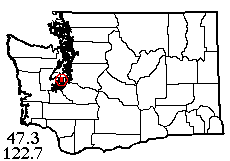 |
![]() 12 V 2014: For my first trip with new volunteer Lindsey Kramer, we picked a comparatively short drive, across the Tacoma Narrows Bridge, up the Gig Harbor Peninsula, across the Purdy-Wauna causeway (where I collected last year), and a few miles across the Key Peninsula to Rocky Creek Conservation Area, recently established on donated land. I first wanted to check out a long wetland east of the park road, which from the air looked as if it could be a Sphagnum bog. We got as close to it as the park's very nice trail system allowed, then struggled through dense salal jungle until there appeared to be open water ahead with Spiraea bushes and alder trees; no bog! Sifting a little litter at the marsh edge did produce 5 spider species. Back on the trail, we started beating salal foliage, clear winner for the day's best habitat at 16 spider species. Included were two real rarities, Rhomphaea fictilium and, for the second time this year, Phanias harfordii. Back along the trail to a little brook (the park trail map calls it Gee Creek) I tried some more litter sifting but it added no new spiders. I had spotted some good moss back by the parking lot, so we headed back there next. Here we met a retired couple who volunteer on the park trail system (they named the Lu Winsor Trailhead for her). The moss was lush, but sifting it added only 3 species that were different. I had spotted a much larger creek to the east below another trail, no doubt Rocky Creek itself, and next we made our way down to that. There were no spiders under the gravel bar rocks, but the shoreline salmonberry foliage was productive of 7 more species including a microspider I don't recognize.
12 V 2014: For my first trip with new volunteer Lindsey Kramer, we picked a comparatively short drive, across the Tacoma Narrows Bridge, up the Gig Harbor Peninsula, across the Purdy-Wauna causeway (where I collected last year), and a few miles across the Key Peninsula to Rocky Creek Conservation Area, recently established on donated land. I first wanted to check out a long wetland east of the park road, which from the air looked as if it could be a Sphagnum bog. We got as close to it as the park's very nice trail system allowed, then struggled through dense salal jungle until there appeared to be open water ahead with Spiraea bushes and alder trees; no bog! Sifting a little litter at the marsh edge did produce 5 spider species. Back on the trail, we started beating salal foliage, clear winner for the day's best habitat at 16 spider species. Included were two real rarities, Rhomphaea fictilium and, for the second time this year, Phanias harfordii. Back along the trail to a little brook (the park trail map calls it Gee Creek) I tried some more litter sifting but it added no new spiders. I had spotted some good moss back by the parking lot, so we headed back there next. Here we met a retired couple who volunteer on the park trail system (they named the Lu Winsor Trailhead for her). The moss was lush, but sifting it added only 3 species that were different. I had spotted a much larger creek to the east below another trail, no doubt Rocky Creek itself, and next we made our way down to that. There were no spiders under the gravel bar rocks, but the shoreline salmonberry foliage was productive of 7 more species including a microspider I don't recognize.
At the edge of the park is a county gravel pit with grassy areas and low-foliage conifers where I had hoped to get many more species. But that whole area is now surrounded by a very high-security fence, complete with warning signs! What the heck is so sensitive about a shallow gravel pit on public land that the public has to be so rigorously kept out? We managed to sweep some bits of grassy field outside the gate for 7 spider species, with one more from conifer branches along the shoulder of the highway. Finally, we drove around looking for other habitats. The west side of the wetland appeared to be just more Spiraea marsh. At the north edge of the park was a powerline clearing that I managed to penetrate a little ways – very rough terrain and a few too many blackberries, but 3 more species swept that hadn't been in the other field habitat. Home in daylight, we had 35 species for the day.
 |
![]() 17 V 2014: For the May Scarabs field meeting, I'd picked the Puyallup Riverwalk Trail, visited last year with Scarab Schimming. Unfortunately as the day approached, NOAA kept warning of a hefty chance of rain. I went with my new friend Sarah to the designated carpool rendezvous, but nobody else showed up. Looking south, we could see patches of blue, so we decided to go for it anyway. At the trailhead parking lot, weather was pleasantly partly-cloudy. We waited about 15 minutes; Scarabs Winner & Palmer were also waiting but just out of sight, and we didn't actually meet them until later. Fortunately, a man and his son from the meetup website did find us, and we hiked the mile to the good habitats together, where I showed them various spider species and collecting techniques. Sarah needed facilities, lacking on this trail, so we headed back and finally met our fellow Scarabs who had somehow hiked the trail also without seeing us! Too bad everyone else was scared off by the forecast, but it was a delightful outing for the 6 of us.
17 V 2014: For the May Scarabs field meeting, I'd picked the Puyallup Riverwalk Trail, visited last year with Scarab Schimming. Unfortunately as the day approached, NOAA kept warning of a hefty chance of rain. I went with my new friend Sarah to the designated carpool rendezvous, but nobody else showed up. Looking south, we could see patches of blue, so we decided to go for it anyway. At the trailhead parking lot, weather was pleasantly partly-cloudy. We waited about 15 minutes; Scarabs Winner & Palmer were also waiting but just out of sight, and we didn't actually meet them until later. Fortunately, a man and his son from the meetup website did find us, and we hiked the mile to the good habitats together, where I showed them various spider species and collecting techniques. Sarah needed facilities, lacking on this trail, so we headed back and finally met our fellow Scarabs who had somehow hiked the trail also without seeing us! Too bad everyone else was scared off by the forecast, but it was a delightful outing for the 6 of us.
Having taken care of needs, Sarah and I decided to head east to an area south of Bonney Lake that still needed spider sampling. The site I'd picked was an undeveloped tract of county park land, Buckley-Bonney Lake Park, recently working timberland but with a housing development just to the east. Walking a quarter mile up the gated logging road, we came to a small grassy clearing rimmed by amazingly varied young conifers: lodgepole pine, Douglas-fir, western hemlock, grand fir and red cedar! Also alder and lots of salal; the past logging hadn't destroyed the understory. I started out beating conifer foliage while Sarah looked for active runners and turned over some log chunks. The conifers produced 16 species in fairly short order. Running about were lots of Pardosa vancouveri, Sarah found one P. dorsuncata and better yet the ground spider Callilepis pluto, very seldom found in this part of the state. Grass-sweeping gave me 8 species, 3 different from the conifer sample. Only 2 of the 11 species from salal added to the list. I had hopes for an illegally dumped sleeping bag and piece of carpet, but their folds contained lots of ants and no spiders. The first batch of leaf litter I tried sifting was rather dry and had no mature spiders. Sarah's time was running short, so we headed back for the car and there, right by the gate, was a nice maple tree with good litter. One netfull added 5 more species for 29 total in quite a short time. Adding in 2 prior records from a Bonney Lake homeowner, I now have 31 for the area. Too bad the county will probably destroy most of the habitat when they develop the park.
 |
![]() 25 V 2014: With volunteer Hannah Dykstra back in action, I wanted to fulfill a long-dormant plan to pick up one or both of two incompletely sampled grid-areas near Ellensburg. Sunday of Memorial Day weekend seemed the right time for an eastern-Washington trip, since rain was predicted for the west side and the holiday traffic would be at its minimum. Traffic-wise, everything worked out great; we made it to Ellensburg without encountering anything serious. Making our way through the town took a little guesswork since my maps pre-dated much recent construction. But we made it to my planned start point on Wilson Creek Road with no major detours, the day being cloudy and "breezy" but dry. To reach my goal, a square mile of state land not crossed by any public roads, I'd planned to hike up a gated irrigation canal service road. I'd even looked at it on Street View and seen no signs on the gate. Well, there are signs there now, no-trespassing as big as life. No other way to access the public land except the other end of the same canal or crossing private ranches. Just where do these bureaucrats get off, prohibiting the public from accessing a large piece of public land! Anyway, I still had a "plan b," an upper stretch of the famous butterfly locality Schnebly Coulee between 120.1 and 120.2 longitude where I'd somehow managed to get only 8 species in years past, all of them from under rocks. Bringing this over 20 should be easy, right?
25 V 2014: With volunteer Hannah Dykstra back in action, I wanted to fulfill a long-dormant plan to pick up one or both of two incompletely sampled grid-areas near Ellensburg. Sunday of Memorial Day weekend seemed the right time for an eastern-Washington trip, since rain was predicted for the west side and the holiday traffic would be at its minimum. Traffic-wise, everything worked out great; we made it to Ellensburg without encountering anything serious. Making our way through the town took a little guesswork since my maps pre-dated much recent construction. But we made it to my planned start point on Wilson Creek Road with no major detours, the day being cloudy and "breezy" but dry. To reach my goal, a square mile of state land not crossed by any public roads, I'd planned to hike up a gated irrigation canal service road. I'd even looked at it on Street View and seen no signs on the gate. Well, there are signs there now, no-trespassing as big as life. No other way to access the public land except the other end of the same canal or crossing private ranches. Just where do these bureaucrats get off, prohibiting the public from accessing a large piece of public land! Anyway, I still had a "plan b," an upper stretch of the famous butterfly locality Schnebly Coulee between 120.1 and 120.2 longitude where I'd somehow managed to get only 8 species in years past, all of them from under rocks. Bringing this over 20 should be easy, right?
We parked at a spot where there was a good supply of sweepable grass. Not very much sagebrush; the shrubs here seemed to have succumbed to a past fire. Since I last collected here, the hills have come alive with dozens of wind turbines. It was windy enough for them to work this day, but fortunately not so much as to severely hamper collecting. Our grass-sweeping produced, to begin with, netloads of the little orbweaver Metepeira foxi. I got two Tibellus chamberlini (a nice record) from some of the tallest grass; also some of the uncommon orbweaver Hypsosinga funebris and a number of Misumenops lepidus flower crab spiders. Hannah got one Xysticus, and that was it for the grass! Beating sagebrush added more of the same, plus two jumping spider species, Pelegrina clemata (good record) and the iridescent Sassacus papenhoei. I got a Mimetus by shaking a tumbleweed over my net. I found a good patch of big flat rocks and got 4 species from that habitat, but two of them duplicated the old records: including my first female of Drassodes angulus, though. We both occupied much time picking cheat-grass seeds out of our socks. At the end of the day we stopped a little farther west in a better sagebrush habitat, where Hannah got one Philodromus histrio (usually numerous on all sagebrush foliage) and I got a Pelegrina helenae. Bottom line: the old sample was boosted to a bare 20 species and the area will have to be visited yet again! I seriously midjudged what we were getting, thinking several things were different when they weren't, and several things (including the one wolf spider Hannah managed to catch) were mature when they weren't. Beyond that, some groups and species that are always common in these habitats, were altogether absent: oxyopids, dictynids, tetragnathids, all zero! Frustrating in a way, but the specimens we did get were good ones, Hannah got some good insect photos (see album), and the burgers at Mountain High Hamburgers abundantly hit the spot, as usual! We found the day's final specimen, a Dermacentor tick, on my arm as we drove away from the site.
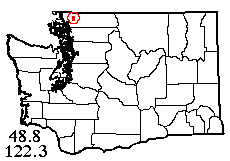 |
![]() 18 VI 2014: Frustrated by a series of missed opportunities in the first half of June, I made a determined effort to arrange field trips this week at all costs. I ended up with two back to back. On the first day, reliable Hannah drove me far north to Lake Fazon in Whatcom County, where I hoped to not only get a sample at one of the few bits of public land in the Nooksack Delta area, but also monitor for recently introduced spiders moving south from Canada. We found the lake with little trouble, and got off to a good start with 4 species from the WDFW outhouse. A very large tall-grass field was adjacent to the boat launch parking lot, but apparently the season is too advanced for grass spider fauna at this low elevation (128 feet) and there was very little except, oddly, Salticus scenicus. The riparian shrubs (including Spiraea and hawthorn) were much better and produced 12 species including Philodromus cespitum, only the third western-Washington record. Next, I wanted to try litter sifting. There were 2 varieties, maple-cottonwood litter in a windbreak which produced the usual early-summer Phrurotimpus and not much else, and wet willow litter by the lake which had no spiders. Back out the driveway to the lake, I found some roadside conifer foliage along the rural road; this and the weedy roadside verge added 6 species. Finally, some mud-wading in rubber boots got me 4 more from the swampy lakeshore habitat, which I couldn't penetrate very far on account of water channels; including a good series of rarely-found Tetragnatha elongata. No newly-introduced spiders, but one European millipede new to the state.
18 VI 2014: Frustrated by a series of missed opportunities in the first half of June, I made a determined effort to arrange field trips this week at all costs. I ended up with two back to back. On the first day, reliable Hannah drove me far north to Lake Fazon in Whatcom County, where I hoped to not only get a sample at one of the few bits of public land in the Nooksack Delta area, but also monitor for recently introduced spiders moving south from Canada. We found the lake with little trouble, and got off to a good start with 4 species from the WDFW outhouse. A very large tall-grass field was adjacent to the boat launch parking lot, but apparently the season is too advanced for grass spider fauna at this low elevation (128 feet) and there was very little except, oddly, Salticus scenicus. The riparian shrubs (including Spiraea and hawthorn) were much better and produced 12 species including Philodromus cespitum, only the third western-Washington record. Next, I wanted to try litter sifting. There were 2 varieties, maple-cottonwood litter in a windbreak which produced the usual early-summer Phrurotimpus and not much else, and wet willow litter by the lake which had no spiders. Back out the driveway to the lake, I found some roadside conifer foliage along the rural road; this and the weedy roadside verge added 6 species. Finally, some mud-wading in rubber boots got me 4 more from the swampy lakeshore habitat, which I couldn't penetrate very far on account of water channels; including a good series of rarely-found Tetragnatha elongata. No newly-introduced spiders, but one European millipede new to the state.
We had nearly 2 hours left before we had to start for home so Hannah could attend a class, and I had 4 species collected by a student on farms in the next gridspace west. The only public access I could find there was Cordata Park at the edge of Bellingham, with a newly developed trail system. Quite a nice trail, with interpretive signs, benches and all – but no parking lot! The spider fauna here (all parts were close to suburban development) was really dominated by introduced species, but we added 9 species to the previous four as the time just melted away. Before I could sift any litter, our time was up! So we headed back to the freeway – and 1.5 blocks before I-5, we were rear-ended by a guy who was texting while driving! At least he was honest and admitted it. One hour later we were finally on our way home, late for Hannah's class but otherwise intact except for a bit of fender-bending. Predicted "mostly sunny" weather didn't materialize, but we only had a few drops of rain.
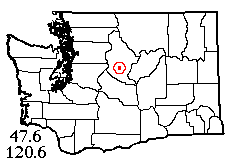 |
19 VI 2014: New volunteer applicant James Abel, a recent Berkeley graduate who had worked with spiders in school, had said he was available for a field trip on Thursday. The forecast had a significant chance of rain on this side of the Cascades, so I opted for a trip plan involving Clark Canyon north of Leavenworth. James showed up on time, with his father and sister providing the transportation, and we had an uneventful trip to sunny Chelan County. The season being a bit late for dry habitats, I stopped first on Chumstick Creek near Clark Canyon's mouth, hoping to get some riparian spiders. But I was only able to beat 2 species from the woodland understory, with James finding a third. Fortunately the leaf litter here was uncommonly rich and added 8 more species.
We moved on to my planned Clark Canyon site, just inside the national forest boundary at the edge of a dry meadow. Sweeping the meadow gave me 6 species, fir foliage 9 (4 of them different), and understory shrubs had nothing different from the other vegetation. While doing this, some branch hooked my camera out of my pocket! Although I tried, I knew finding it was hopeless in thousands of square feet of complex surface with sticks, dense plants, tree trunks, and shifting shadows. So that is why this field trip has no photo album! Finally, I applied the Laurel Ramseyer technique to 55 pine cones in a small clearing off the main meadow. The pine cone fauna was extremely rich, adding 6 species to what we already had. We got nothing extremely rare here, but recorded 24-26 spider species plus one being reared. The family needed to return to civilization, so up-canyon habitats remain unsampled.
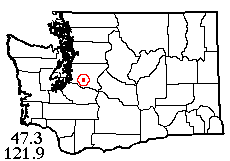 |
![]() 28 VI 2014: The year's second official Scarabs outing was led by treasurer Dick Palmer to the "Landsburg Reach" of the Cedar River, in the same gridspace as the Green River Gorge bridge whence I had 22 species from olden times. But I figured I could add some more now, and anyway no other outing was in prospect. Sarah and I picked up Scarab DeYoung and a new chap at the carpool rendezvous, headed south, and found the trailhead with no difficulty; the other car found it with only one false turn. The vegetation was wet with rain, eliminating foliage-beating from my possibilities. My first species dropped on me at the trailhead. Then, eight of us all hiked in to Dick's favorite river bank with only occasional rain sprinkles, and I sifted 4 species from moss. Soon after that, the clouds burst! Fortunately my pith helmet still sheds rain, but collecting was all over for that day…
28 VI 2014: The year's second official Scarabs outing was led by treasurer Dick Palmer to the "Landsburg Reach" of the Cedar River, in the same gridspace as the Green River Gorge bridge whence I had 22 species from olden times. But I figured I could add some more now, and anyway no other outing was in prospect. Sarah and I picked up Scarab DeYoung and a new chap at the carpool rendezvous, headed south, and found the trailhead with no difficulty; the other car found it with only one false turn. The vegetation was wet with rain, eliminating foliage-beating from my possibilities. My first species dropped on me at the trailhead. Then, eight of us all hiked in to Dick's favorite river bank with only occasional rain sprinkles, and I sifted 4 species from moss. Soon after that, the clouds burst! Fortunately my pith helmet still sheds rain, but collecting was all over for that day…
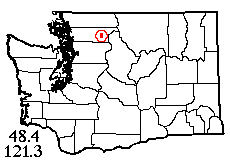 |
![]() 9 VII 2014: Fred Austin had now been back a while from his annual walking tour of the British Isles, so I mooted a local hike with him and he was amenable. To get out of the increasingly warm lowlands, Fred, Jerry and I headed for Slide Lake in the North Cascades. The trip in was uneventful and the 20-mile dirt road to the trailhead was (fortunately) in better shape than the Forest Service said. Waiting for the Austins to get started, I thought I'd stroll up the trail a ways to get out of the hot sun. I kept strolling, stopping for an occasional photo, but they didn't catch up. Trail crews have done a great job of maintaining this one, cutting through gigantic old growth windfall logs; in fact, a crew was working on this year's windfalls as I hiked through. And in one of the many bouldery stretches, a pika (possibly two) eenked at me from not very far off.
9 VII 2014: Fred Austin had now been back a while from his annual walking tour of the British Isles, so I mooted a local hike with him and he was amenable. To get out of the increasingly warm lowlands, Fred, Jerry and I headed for Slide Lake in the North Cascades. The trip in was uneventful and the 20-mile dirt road to the trailhead was (fortunately) in better shape than the Forest Service said. Waiting for the Austins to get started, I thought I'd stroll up the trail a ways to get out of the hot sun. I kept strolling, stopping for an occasional photo, but they didn't catch up. Trail crews have done a great job of maintaining this one, cutting through gigantic old growth windfall logs; in fact, a crew was working on this year's windfalls as I hiked through. And in one of the many bouldery stretches, a pika (possibly two) eenked at me from not very far off.
Slide Lake, formed long ago by a boulder landslide damming the valley, was extremely full, and shoreline meadows (plus a willow stand) were all underwater. Fred & Jerry caught up while I was looking for habitats. At a place where the trail descends toward the water, I beat a bunch of diverse shrubs and a little un-submerged grassy strip to get a satisfactory 9-10 species including uncommon Theridion saanichum. A very small amount of conifer foliage added two more. Several orbweaver species were around, but all disappointingly juvenile. Meanwhile, Jerry had gone further up the lake shore and found a fern-fireweed meadow, where he swept 10 species, 6 different from my beat sample. Back where Fred was taking it easy by the lake, I was tapping fallen bark pieces; Jerry, who was trying the same habitat by eye alone not far away, thought it was a woodpecker!
We all packed up and headed out just before 7 PM; I stopped at a vine maple thicket at the lower end of the lake to sift litter (which added 2 species) and moss (adding 2 more, one of them uncommon Sisis rotundus). We all did some conifer foliage beating near a pond below the main lake, adding the only mature Dictyna taken. Finally both Jerry and I swept roadside verge by the trailhead, adding one more species each. End result, at least 29 species, possibly 30. A long day but some good exercise and lots of solitude! Also I inaugurated my new (used) camera.
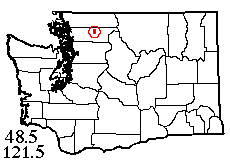 |
![]() 1 VIII 2014: Scarab Angela Winner responded to my plea at the meeting for someone to help complete the summer field season. Her availability was Friday, and on Thursday night the weather forecast changed to 40% chance of thunderstorms at my original planned site, a bit too much for my taste. I talked Angela into trying Sauk Mountain instead, with only 30% thunderstorm chance. On 15 August 2012, three of us had climbed and collected this popular peak and ended with only 19 spider species. Two weeks earlier this year, I thought we couldn't possibly miss getting 2 more. We arrived at the trailhead without incident and headed up the steep meadow switchbacks in vigorous fashion. A butterfly-watcher would have gone hog-wild here. About 70% of the way up, feeling much less vigorous, we started taking frequent rest breaks, on one of which Angela spotted a very attractive jumping spider on a rock face. It turned out to be a male Dendryphantes nigromaculatus (we'd taken females in 2012). Finally on top, I decided to skip vegetation sampling which had produced very little before, and both of us worked on turning rocks for some time. Angela found a very interesting harvestman (Togwoteeus sp.?) but I got just one solitary mature spider, Lepthyphantes pollicaris, also taken in 2012.
1 VIII 2014: Scarab Angela Winner responded to my plea at the meeting for someone to help complete the summer field season. Her availability was Friday, and on Thursday night the weather forecast changed to 40% chance of thunderstorms at my original planned site, a bit too much for my taste. I talked Angela into trying Sauk Mountain instead, with only 30% thunderstorm chance. On 15 August 2012, three of us had climbed and collected this popular peak and ended with only 19 spider species. Two weeks earlier this year, I thought we couldn't possibly miss getting 2 more. We arrived at the trailhead without incident and headed up the steep meadow switchbacks in vigorous fashion. A butterfly-watcher would have gone hog-wild here. About 70% of the way up, feeling much less vigorous, we started taking frequent rest breaks, on one of which Angela spotted a very attractive jumping spider on a rock face. It turned out to be a male Dendryphantes nigromaculatus (we'd taken females in 2012). Finally on top, I decided to skip vegetation sampling which had produced very little before, and both of us worked on turning rocks for some time. Angela found a very interesting harvestman (Togwoteeus sp.?) but I got just one solitary mature spider, Lepthyphantes pollicaris, also taken in 2012.
So we hiked farther in, down the trail toward Sauk Lake in hopes of more species in treeline forest habitats, 200 feet of elevation below the ridge. In a tree group on top, I'd managed to find lots of specimens from needle-litter in 2012, but only 2 species. Surely there'd be more farther down! Nope, only the same two. Meanwhile I had Angela collecting from dead-wood habitat. This did add Cybaeus reticulatus to the old records. Hard to believe, but we still need to climb this bloomin' mountain one more time to get that 21st species! Now the weather was getting ominous. We heard several distant thunderclaps and, heading out, saw rain on the next ridge north. More to the south. "Clouds to right of them, clouds to left of them, volley'd and thunder'd." But the trail down passed with comparative ease; young people in shorts still climbing the mountain at 6:00 and 7:00 PM! Rain, not very intense, finally fell on us about 10 minutes from the car. Now our luck changed for the better: Cascade Burgers in Concrete was still open with those great retro burgers.
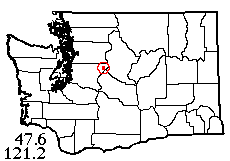 |
![]() 4 VIII 2014: For my last summer field trip with Hannah, I selected the Tonga Ridge Trail (near Skykomish) where we could do a lower elevation sample on the road to the trailhead, then pass through varied subalpine habitats along two semi-level miles before ascending toward the 5500-foot peak of Mt. Sawyer. By a lucky chance Jerry Austin managed to join us, though he'd thought we were starting a half-hour later! The drive went without incident and halfway up the switchbacks of Road 6830, I had Hannah stop at a spot with wide grassy roadside verge. Sweeping this in the hot sun got me little but the introduced harvestman Phalangium opilio. But on the shady side of the road it was a different story. Conifer foliage added some more, and our fortunate half-hour at this site left us 13 spider species to the good, including unfamiliar Dipoena and Poeciloneta species. Also some ripe red huckleberries.
4 VIII 2014: For my last summer field trip with Hannah, I selected the Tonga Ridge Trail (near Skykomish) where we could do a lower elevation sample on the road to the trailhead, then pass through varied subalpine habitats along two semi-level miles before ascending toward the 5500-foot peak of Mt. Sawyer. By a lucky chance Jerry Austin managed to join us, though he'd thought we were starting a half-hour later! The drive went without incident and halfway up the switchbacks of Road 6830, I had Hannah stop at a spot with wide grassy roadside verge. Sweeping this in the hot sun got me little but the introduced harvestman Phalangium opilio. But on the shady side of the road it was a different story. Conifer foliage added some more, and our fortunate half-hour at this site left us 13 spider species to the good, including unfamiliar Dipoena and Poeciloneta species. Also some ripe red huckleberries.
The comparatively easy Tonga Ridge trail has short ascents and descents with long level stretches. After a while, vistas open with Mount Daniel and other peaks. Finally it was evident that we were passing Mt. Sawyer, but none of the several side trails was marked by the expected rock cairn. We did come to the right one, the cairn in this case being a rock group in mid-trail. Now we were going up, up. I stopped just before treeline because I wanted forest-habitat spiders. A hiker group we met, told I was collecting spiders for research, thought I'd said for my church. "The Church of the Arachnids?" With some misgivings, I agreed to Jerry continuing on up toward the peak. I'd been sifting conifer litter for about an hour when Hannah found me and said she was returning to the car due to alimentary upset, but we should go on without her. Soon I finished sifting, hoping I'd got more than two species this time. No such luck, it was those same two! But a little downslope I encountered a propitious log whose fragments added 5 more forest floor species. Too bad there was no second log.
Returning to the trail above (so as not to miss Jerry on his way down) I beat conifer foliage for a while, tantalized by the usual juvenile orbweavers. Then, a vision floating in mid-air, a huge mature Araneus nordmanni appeared before me; luckily nothing disturbed it before I got it. Jerry finally meandered back down from his sub-summit site, having added 3 nice species. First I heard him sneeze, and thought he was very close, but his voice sounded far distant when I called. Must have been some sneeze! We made one last stop at a subalpine sedge meadow that must be a temporary pool at some seasons, where we got nice series of Pityohyphantes minidoka and Dictyna major, then continued out to the car, arriving just before sunset to find Hannah feeling much better. A rigorous trip with plenty of flies and mosquitos, but successful with 25 species taken where none were known before.
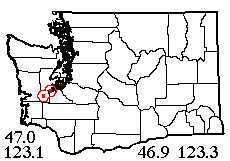 |
![]() 6 X 2014: After some bad luck with spring field volunteer applicants (out of 4, 2 made it to no field trips and the other 2 to one apiece), I recruited 5 new ones for fall. It paid off! For the first time in my entire career, 3 volunteers showed up for a single trip! Michael Sweepe (who'll be my main field helper for fall, since he's doing it as an internship), Alex Sturbaum and Gene Wan have a nice assortment of backgrounds. On this summer-like day, we headed south intending to turn west at Olympia. Spider question-and-answer got so absorbing, however, we overshot by about 20 miles! Somewhat belatedly we arrived at the first site, on Kennedy Creek Road in eastern Thurston County where we strolled up the gated logging road to an old gravel pit (with a pond), hoping to supplement a very old 6-species sample from nearby. After 2 months in city air, the woods smelled delightfully woodsy, and habitats in this working forest were surprisingly varied.
6 X 2014: After some bad luck with spring field volunteer applicants (out of 4, 2 made it to no field trips and the other 2 to one apiece), I recruited 5 new ones for fall. It paid off! For the first time in my entire career, 3 volunteers showed up for a single trip! Michael Sweepe (who'll be my main field helper for fall, since he's doing it as an internship), Alex Sturbaum and Gene Wan have a nice assortment of backgrounds. On this summer-like day, we headed south intending to turn west at Olympia. Spider question-and-answer got so absorbing, however, we overshot by about 20 miles! Somewhat belatedly we arrived at the first site, on Kennedy Creek Road in eastern Thurston County where we strolled up the gated logging road to an old gravel pit (with a pond), hoping to supplement a very old 6-species sample from nearby. After 2 months in city air, the woods smelled delightfully woodsy, and habitats in this working forest were surprisingly varied.
Sifting willow-cottonwood litter by the pond didn't yield very much, but still added 6 species. Michael found one cross spider in her aerial web, then we all beat young Douglas-firs for no less than 18 species! This included a Rhomphaea fictilium and other good stuff. Finally, 3 of us (I'd only brought 3 nets) swept the meadow habitat, mostly sedge, in an area that must usually have standing water. To my amazement, the commonest species in the sweep sample (partly swept by M. Sweepe) was juvenile fishing spiders, usually so rare in western Washington. Other wetland specialists were present too; this pond must have been in the gravel pit for a very long time. With the old records, I now have 31-33 species from this area, after about a 2-hour visit.
Next stop was the town of Porter, farther west and south, right on the Chehalis River. We parked at a saloon on Main Street to hunt for house spiders on fence, walls, and a shed; the shed was very productive and gave us a 5-species start on the gridspace, including a series of hobo spiders from under some cardboard. Right across the bridge from Porter is a state fishing access site, from which I sent my 3 helpers in 3 directions sweeping grassy fields while I sifted cottonwood litter. The litter, rather sparse and dry, added only 5 species, but sweeping added 11 more including some native orbweavers.
A nearby county gravel pit is posted; seems like all counties are doing this now, and that's the pits! But we located a non-posted tract of private forest land to the west, where we hardly had to go beyond the road right-of-way to get excellent fir-foliage, moss-sifting and understory-beating samples, including the increasingly hard-to-find Araneus marmoreus. Finally we drove a couple of miles down the river from Porter to a spot where some maple litter was perched precariously between the riverbank and the railroad tracks. Of course, a freight train went by while we were sifting. But the maple-litter species added to those from cottonwood litter, and brought us up to a nice even 40 species from around Porter. One day, two big samples!
 |
![]() 13 X 2014: This week's weather promised to be wet, so an eastern Washington trip was in order. Not too far east this time, just over the pass and off I-90 at an exit between Easton and Cle Elum. Personnel were me, Michael and Alex. Our goal was a fairly short Forest Service road leading to a mid-elevation trailhead. But today was our day for wrong turns! First, we continued on what seemed the main road instead of turning right, where the old main road is now a side road. Since the map, people have been building houses! We came to a powerline – yes, that seemed right, but every route onward ended in someone's driveway! A road work crew had no clue – "We're from Yakima." Heading back out, ready to give up and head for another site, we stumbled on the turn we'd missed, leading to the right powerline, lots of potholes and finally a ridge with a good number of Ponderosa pine trees. Thinking of Laurel, I stopped for a sample.
13 X 2014: This week's weather promised to be wet, so an eastern Washington trip was in order. Not too far east this time, just over the pass and off I-90 at an exit between Easton and Cle Elum. Personnel were me, Michael and Alex. Our goal was a fairly short Forest Service road leading to a mid-elevation trailhead. But today was our day for wrong turns! First, we continued on what seemed the main road instead of turning right, where the old main road is now a side road. Since the map, people have been building houses! We came to a powerline – yes, that seemed right, but every route onward ended in someone's driveway! A road work crew had no clue – "We're from Yakima." Heading back out, ready to give up and head for another site, we stumbled on the turn we'd missed, leading to the right powerline, lots of potholes and finally a ridge with a good number of Ponderosa pine trees. Thinking of Laurel, I stopped for a sample.
Nearly all the pine cones were old and disintegrating. The one pine-cone spider I got, though, was Scotinella sculleni which we'd never taken from cones before. Dead wood and pine bark scales produced nothing here. Michael and Alex added several species from vegetation, to which I added a Tibellus from roadside grass. A fellow collector passing by was after mushrooms. Time to head for our main site of the day, Big Creek on the trail of the same name. We made it to a trailhead with the right signs (and a group camping with their donkeys) with no trouble. But it wasn't the same trailhead shown on the map! Heading down the trail, it was crossed by a trail-like old road. No sign to indicate the right way, but the old road soon ended. Soon, the trail crossed another road, very clear and with a sign – which said, only, "Temporary Sign." This seemed like it might be the fork where Big Creek Trail branches off from North Ridge Trail, so we followed it, found a very well marked trail at its end, but in a quarter mile said trail petered out. Back to the drawing board! Further down the "real" trail, now signed only North Ridge Trail, we finally came to the true fork toward Big Creek. Once on the right trail we had no trouble attaining the canyon bottom, but it was obvious we'd get a workout climbing back out!
Our site had been informally improved with a home-made picnic table, very handy for sifting, and even welcome mats – some of which had spiders under them. I set Alex to turning over wood and other objects, Michael to vegetation sampling, while I sifted. The cottonwood-vinemaple litter was the best so far of the season with 12 species. However, Alex (and later Michael too) got the site's best species under wood, including 3 different Cicurina, a nice Anyphaena and Bathyphantes malkini. The ravine is so deep that the sun doesn't stay on the bottom; conditions were gloomy by mid-afternoon. Before heading out, I got a couple more species under stream-bank cobbles. Beating the trailside huckleberries added yet 2 more, making 31 for the day. The fall colors are just getting good over on the east slope. And we managed to retrace our path to the freeway without a single wrong turn, practice makes perfect!
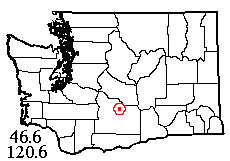 |
![]() 19 X 2014: Today's personnel were Michael, me, and new volunteer Laurie Line. Most western Washington sites probably had wet bushes from yesterday, so we once again headed over the mountains, Michael listening to a football game (his team lost). We first stopped near the area on the Vantage Highway where I and Hannah had missed a full sample by one species this past spring. Surprisingly dense fog in the Kittitas Valley was just burning off. The good news, in a half hour or so we added 3 species, including a spectacular Argiope Michael spotted in her web. The bad news, I tripped over an old bedspring in a gully and emerged with the hand that dripped blood. But we had plenty of alcohol to sterilize it. Then on south toward Yakima, aiming for the Cowiche Canyon nature preserve where I had permission to collect. We reached the parking lot with nary a wrong turn!
19 X 2014: Today's personnel were Michael, me, and new volunteer Laurie Line. Most western Washington sites probably had wet bushes from yesterday, so we once again headed over the mountains, Michael listening to a football game (his team lost). We first stopped near the area on the Vantage Highway where I and Hannah had missed a full sample by one species this past spring. Surprisingly dense fog in the Kittitas Valley was just burning off. The good news, in a half hour or so we added 3 species, including a spectacular Argiope Michael spotted in her web. The bad news, I tripped over an old bedspring in a gully and emerged with the hand that dripped blood. But we had plenty of alcohol to sterilize it. Then on south toward Yakima, aiming for the Cowiche Canyon nature preserve where I had permission to collect. We reached the parking lot with nary a wrong turn!
There were no spiders in the outhouse, to start with. Adjacent to the parking lot were some big Russian olive trees with litter begging to be sifted. But a big thicket of wild rose in the way. Fortunately we found a way to make an end run (in honor of the football game) to the back of the grove. Litter here was really too dry, but produced 3 identifiable species. Wood on the ground had only Tegenaria under it. Michael swept 4 good species, then we moved on up the trail. First and best stop beyond the trailhead was a big grove of cottonwoods whose interior was trackless and all but impenetrable with all the crisscrossing branches. Litter sifting (of what I could reach) was not too bad though, eventually producing 10 species after a heroic safari into the interior. Meanwhile, Laurie and Michael took another route to the creek bank and returned with a netfull of willow litter, adding 3 more species not in the cottonwood.
Further up-canyon we made 3 more stops. At one, Michael got a few pine-foliage spiders and a couple more from dry bunchgrass while I swept 3 good ones from creek-bank grass. At our furthest site, we all beat sagebrush getting 5 species (unfortunately both the Habronattus were juvenile) and I found a very peculiar harvestman under a rock. Finally we all tried turning rocks in an outcrop area (Laurie: "This is hard!" after losing a couple of fast ones). A couple of quick sweeps on the way back to the car ended our day at dusk, with 28 identifiable species. The trail was nice and scenic with clear fall sunlight and bright fall colors: also lots of people with horses, dogs, and especially questions!
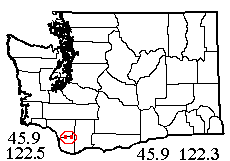 |
![]() 8 XI 2014: About 20 days after the previous trip, we again had dry enough weather to head for the field. This time I wanted to try a nice long foray into far southern Washington, where I had a couple of partial samples to complete along the Lewis River. Michael, Gene and I left Seattle early and were near Yale by noon, in gorgeous sunny weather (a relief, since it had been overcast from Olympia to Castle Rock). We first drove to what we presumed was recreational land near Saddle Dam (lower end of Yale Reservoir). Yes it was, but closed to traffic for the season; however, we were able to park at the entrance and collect. Despite being the second dry day in a row, leaf litter was very wet and didn't sift very efficiently; however, I still got 11 spider species from it. Sifting moss added six more. Michael had been beating conifers, but oddly enough he got mostly grass-habitat species from them (the most productive trees must have been beside a field). Gene got some good fern-understory species and learned the hard way to avoid getting one's net soaking wet!
8 XI 2014: About 20 days after the previous trip, we again had dry enough weather to head for the field. This time I wanted to try a nice long foray into far southern Washington, where I had a couple of partial samples to complete along the Lewis River. Michael, Gene and I left Seattle early and were near Yale by noon, in gorgeous sunny weather (a relief, since it had been overcast from Olympia to Castle Rock). We first drove to what we presumed was recreational land near Saddle Dam (lower end of Yale Reservoir). Yes it was, but closed to traffic for the season; however, we were able to park at the entrance and collect. Despite being the second dry day in a row, leaf litter was very wet and didn't sift very efficiently; however, I still got 11 spider species from it. Sifting moss added six more. Michael had been beating conifers, but oddly enough he got mostly grass-habitat species from them (the most productive trees must have been beside a field). Gene got some good fern-understory species and learned the hard way to avoid getting one's net soaking wet!
I wanted to try for some better leaf litter in the vicinity, so we parked along the spur highway (Yale Bridge Road) and I walked up to a grove of tall cottonwoods. The six spider species (plus a mature Taracus) sifted here in under an hour had only one in common with the first sift sample. And I managed to recover my nearly-lost camera (fell out for the second time this year!). Michael and Gene had been beating somewhat better conifer foliage by the parking spot, getting Ceraticelus fissiceps and Neriene radiata among others. They also found a large black plastic bag full of bones! (Deer, I suspect, but just to be on the safe side Michael reported it to the Cowlitz County Sheriff). Total for the area, 35 species (40 with prior records).
Our last stop was Merwin Park at the lower end of Lake Merwin, to supplement a 19-species sample from Sue Baker's timber harvest pitfall studies. We had one hour before dark; while Michael and Gene collected 2 orbweaver species around the big restroom building, I sifted good maple litter, swept some grass and beat some conifers all at top speed for a total of 17 species (making 35 with Sue's records). Now, what's that big hullaballoo in the parking lot? Michael didn't know there was a "panic button" on his electronic car key! The drive home went quickly and without incident; a productive trip.
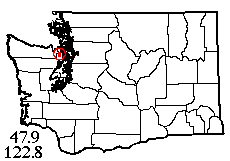 |
![]() 19 XI 2014: Since the 8th, weather had been mostly dry, but cold. I was tempted to do a trip anyway but decided to hold out for 50° or better. Finally, at the very end of the dry spell NOAA forecast a high of 53 in my proposed area near Chimacum (NE Olympic Peninsula) where I had adjacent prior samples of 3 and 1 species. We (Michael, Alex and I) decided saving a few minutes wasn't worth the expense of a ferry ride, so we drove around via Tacoma (with a couple of minor delays). We found my first planned site, Gibbs Lake County Park, with little trouble. The place was attractive (mostly cedar forest, oddly enough), just about deserted – and cold! 53 nothing, it felt more like 43. Hiking down the Walt Hoffman trail, we soon reached my first planned habitat, the edge of an alder swamp at the south end of the lake. In pale sunlight, habitats looked promising. However, I knew I was in trouble when my first sift of alder litter sprinkled ice crystals on the cloth!
19 XI 2014: Since the 8th, weather had been mostly dry, but cold. I was tempted to do a trip anyway but decided to hold out for 50° or better. Finally, at the very end of the dry spell NOAA forecast a high of 53 in my proposed area near Chimacum (NE Olympic Peninsula) where I had adjacent prior samples of 3 and 1 species. We (Michael, Alex and I) decided saving a few minutes wasn't worth the expense of a ferry ride, so we drove around via Tacoma (with a couple of minor delays). We found my first planned site, Gibbs Lake County Park, with little trouble. The place was attractive (mostly cedar forest, oddly enough), just about deserted – and cold! 53 nothing, it felt more like 43. Hiking down the Walt Hoffman trail, we soon reached my first planned habitat, the edge of an alder swamp at the south end of the lake. In pale sunlight, habitats looked promising. However, I knew I was in trouble when my first sift of alder litter sprinkled ice crystals on the cloth!
Forging ahead, I sifted 3 bags of the half-frozen alder litter, seeing just enough polar-bear spiders moving on the cloth to keep me hopeful. But in the end, only one species was identifiable from the 3 bags. One bag I brought home and warmed up, on the other hand, had seven plus a good harvestman, well worth doing. A bag of maple litter added 2 more, 3 bags of moss another 2: slow going! Meanwhile, Alex on the ferns and Michael on the conifers were raking in spiders hand over fist, though not very high diversity. Each got well over a hundred Theridion sexpunctatum, though. Clearly, all our sampling at this site was marred by many species being too cold to move.
With an hour's daylight left, we walked up the road from the parking lot seeking other habitats, and found them. A side track just past a private inholding, led to an outhouse (one spider inside) followed by a little lake-shore lawn with a picnic table. Maybe I'd have had better luck sifting here, oh well. Anyway, I and Michael swept along the lake shore adding 3 species while Alex got a nice Walckenaeria auranticeps from the salal. The full spider catch for Gibbs Lake was 24 species making 25 with the one old record; not spectacular, but not a failure either. And we crossed Egg & I Road, where the events of one of my lifelong favorite books took place.
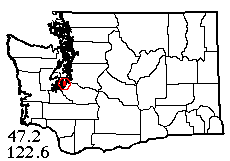 |
![]() 14 XII 2014: Unexpectedly, a 3-day dry spell that wasn't too cold materialized, and I planned a field trip for the day after the Scarabs Yule party. Michael wasn't available, but Gene Wan stepped into the breach, both driving and helping collect. Our destination (a nearby one because of the short days) was little-known Fox Island, 13 miles past the Tacoma Narrows Bridge and across another, causeway-type bridge. My research had found a site called Fox Island Nature Center and Wildlife Preserve, set up cooperatively by the island homeowners association and local boy/girl scouts. The site is just over 5 acres but has what must be over a mile of trails through varied habitats, with stepping stones, boardwalks, bridges, low-tech but legible interpretive signs, the whole works. Nice job, scouts! Nobody was around on this bright, cool morning. In search of the best leaf litter, we hiked to the very rear of the property, and I started sifting while Gene beat tree foliage. The litter must have been just a little too cold and wet, and gave me only one spider species (a bag brought home added 4 more). But by the time I gave up sifting, the fern understory was dry and fairly rich in spiders (8 species). Gene's tree beating added 5 different ones (his technique is improving) and we came away from the first site with 18 spider species and assorted other creatures.
14 XII 2014: Unexpectedly, a 3-day dry spell that wasn't too cold materialized, and I planned a field trip for the day after the Scarabs Yule party. Michael wasn't available, but Gene Wan stepped into the breach, both driving and helping collect. Our destination (a nearby one because of the short days) was little-known Fox Island, 13 miles past the Tacoma Narrows Bridge and across another, causeway-type bridge. My research had found a site called Fox Island Nature Center and Wildlife Preserve, set up cooperatively by the island homeowners association and local boy/girl scouts. The site is just over 5 acres but has what must be over a mile of trails through varied habitats, with stepping stones, boardwalks, bridges, low-tech but legible interpretive signs, the whole works. Nice job, scouts! Nobody was around on this bright, cool morning. In search of the best leaf litter, we hiked to the very rear of the property, and I started sifting while Gene beat tree foliage. The litter must have been just a little too cold and wet, and gave me only one spider species (a bag brought home added 4 more). But by the time I gave up sifting, the fern understory was dry and fairly rich in spiders (8 species). Gene's tree beating added 5 different ones (his technique is improving) and we came away from the first site with 18 spider species and assorted other creatures.
The other half of our Fox Island sample was from Nearns Point, aka Fox Island Sandspit county park. A relatively small park but it has a nice tract of maple-cottonwood littoral forest, plus a 186-meter long sandspit (actually fine gravel on the bay side and sand on the leeward side). Not as high quality spit habitat as English Boom, but well worth a visit anyway. Here we had high quality maple litter to sift, warmer temperature to sift in, and a picnic table to sift on! Sifting got me 7 spider and 2 harvestman species and a bag brought home added only one species. I got 3 more species from a park storage building and Gene got 10 from fern understory. A couple of families with kids visited the beach during the afternoon but for the most part we had scenic, sunny solitude – so quiet we could hear a dog nearly a mile across the water. Sweeping on the spit was less productive but still worth doing; this site brought us over 30 species for Fox Island (none known there before).
There was a half hour of daylight left, shortened further by wrong turns, but I wanted to pay a token visit to Wollochet Bay Estuary Park – still in the same grid area – on the way home. I'd hoped to sweep a tidal marsh, but any route to these that may exist wasn't visible in the fading light. However, beating a handy Douglas-fir added 4 species and one bag of maple litter, 3 more. Total for the day, possibly as many as 39 species, not bad at all for December.
That turned out to be all for 2014 — but stay tuned for 2015!
This page last updated 21 March, 2025